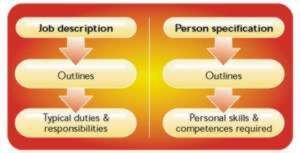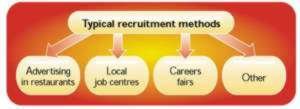The importance of recruitment
For McDonald’s, people are its most important asset. This is because customer satisfaction begins with the attitudes and abilities of employees and committed, effective workers, are the best route to success. For these reasons, McDonald’s strives to attract and hire the best, and to provide the best place to work.

All businesses experience staff turnover for various reasons e.g. career change, leaving the area, returning to education, or a new opportunity elsewhere. Recruiting and training staff is very expensive and businesses will look to keep staff turnover to a minimum. One way of doing this is to ‘choose wisely, and treat well’.
McDonald’s needs people who want to excel in delivering outstanding service. To ensure the company recruits the right people, it has identified essential skills and behaviours that applicants should be able to demonstrate. For each position, there is a job description outlining typical duties and responsibilities and a person specification defining personal skills and competencies.
Recruiting suitable applicants
Under McDonald’s recruitment policy, each individual restaurant is responsible for filling hourly-paid positions. The Management Recruitment department in East Finchley co-ordinates the recruitment of managers. For recruiting hourly-paid employees McDonald’s uses several avenues. Positions are generally advertised in the restaurant. The company’s recruitment history shows this is the best method of hiring quality staff e.g. people living locally and/or friends of existing employees. McDonald’s also uses local job centres, career fairs and other local facilities. It is vital to use effective hiring material with a clear message targeted at the right audience.

A recruitment exercise often generates more applications than there are positions available. The manager will select the applicants to be interviewed and will conduct the interviews.
Over 60% of restaurant crew are aged 20 or under and; for the majority of applicants, a job with McDonald’s would be their first experience of employment. For many young people, McDonald’s also offers a career opportunity. A well-run interview will identify an applicant’s potential to be a successful McDonald’s employee. To find people who will be committed to excelling in delivering outstanding service, McDonald’s scripts an interview guide that helps the company predict how an applicant’s past behaviour is likely to influence future performance. It uses a fact-based decision-making process. The questions look for actual events or situations rather than allowing applicants to give a general or theoretical response. Interviewers look for behavioural evidence in the applicant’s life history that fits with the requirements of the job. The interviewer rates candidates on their responses and offers jobs to those who earn the highest ratings.
McDonald’s future managers come from two main sources. More than half of all salaried management positions are taken up by hourly-paid employees who earn a promotion. The remainder is predominately graduates. Wherever possible, McDonald’s directs applicants towards applying online at www.mcdonalds.co.uk. People who cannot access the web can call the Recruitment Hotline, or pick up a pre-paid Business Reply Card from a McDonald’s restaurant. The selection process includes an initial online psychometric test. This test produces an initial score. The applicant then attends a first stage interview and is offered “On Job Experience” (OJE). This is a 2-day assessment in a restaurant. Successful completion at OJE will lead to a final interview, after which the manager decides whether or not to hire the applicant
Appointing the suitable applicant

After the final interview, the manager will rate the applicant’s responses. A successful applicant will have demonstrated skills and behaviours that have been identified as being key to the position. S/he will also have produced documents to show s/he is eligible to work in the UK in line with the Asylum and Immigration Act 1996. The first stage is to notify all candidates whether their application has been successful pending satisfactory references. The company notifies all unsuccessful applicants in writing. McDonald’s inducts all new employees into the business through a Welcome Meeting, which they must attend. The Welcome Meeting gives an overview of the Company, including:
- job role
- food, hygiene and safety training
- policies and procedures
- administration
- benefits
- training and development.
New employees will also meet their trainer, and tour the restaurant. The company operates a 3-week probationary period, after which employees are rated on their performance and are either retained or have their employment terminated.
Training at McDonald’sRestaurants Limited

McDonald’s success is built on the highest standards of quality, service and cleanliness delivered to customers in each of its restaurants. Well-trained crew and managers are the first steps to achieving these standards. It is company policy to provide career opportunities that allow employees to develop their full potential. This includes a comprehensive training programme for crew and operations management and career progression that enables a ‘first job’ employee to progress through to a senior management position through merit-based promotions.
The first stage of training is at the Welcome Meetings. These set out the company’s standards and expectations. This is followed by a structured development programme that provides training in all business areas. Crew trainers work shoulder-to-shoulder with trainees while they learn the operations skills necessary for running each of the 11 workstations in each restaurant, from the front counter to the grill area. All employees learn to operate state-of-the-art food service equipment, gaining knowledge of McDonald’s operational procedures. The majority of training is floor based, or “on-the-job” training because people learn more and are more likely to retain information if they are able to practise as they learn. All new employees have an initial training period. Here they are shown the basics and allowed to develop their skills to a level where they are competent in each area within the restaurant. The time scale for this depends on their status i.e. full or part-time. They will also attend classroom-based training sessions where they will complete workbooks for quality, service and cleanliness.
After the initial training period, all employees receive ongoing training. This is done using “Observation Checklists” for the station they are working at. The rating will go towards their appraisal grading. The restaurants do promote crew members to hourly-paid management positions that carry accountability for areas within the restaurant, or responsibility for a shift. Training and development is given in the restaurant and in addition, the participants will attend regular development days. On successful completion of a management entrance exam, employees will attend a training course held by the training department at the regional office before returning to the restaurant in a management position.
Management Development
The McDonald’s Management Development Curriculum takes new recruits from trainee manager to Restaurant Manager. This consists of on-the-job training and open learning development modules, supported by courses and seminars at the Company’s National and Regional Training Centres. The Management Development Curriculum is aimed at persons aged 21 or over, either graduates or individuals with some previous management experience. It offers a direct route into restaurant management, through an intensive structured training programme. The Management Development Curriculum is divided into four key programmes:
- Shift Management – developing trainee managers in the skills and techniques required to become effective in all aspects of running a shift.
- Systems Management – targeting second assistant and newly promoted first assistant managers. This programme covers all areas of McDonald’s systems, increasing the manager’s business knowledge. It also develops individual techniques.
- Restaurant Leadership – introducing managers to the key skills needed to become effective restaurant leaders e.g. team-building, communication, decision-making.
- Business Leadership – focusing restaurant/general managers on the need to develop a business strategy that encompasses both internal and external factors.
Most departments in the regional offices offer restaurant managers opportunities to be seconded to work in the regional office. This gives an experienced manager the opportunity to develop and learn new skills, to see a different side of the business and to experience how each department’s strategies have a role in achieving the company’s goals.
Conclusion

McDonald’s believes that the success of the restaurants and the company is achieved through the people it employs. The company aims to recruit the best people, retain them by offering ongoing training relevant to their position and promote them when they are ready. Its recruitment policies, procedures and practices reflect the company’s determination to fulfil its aim.
